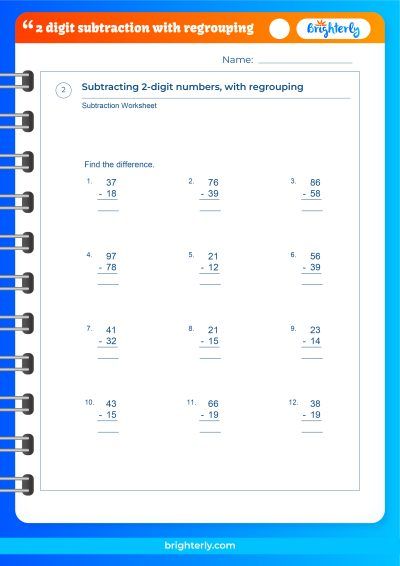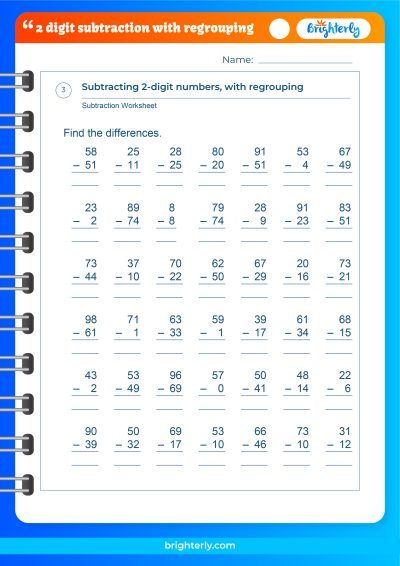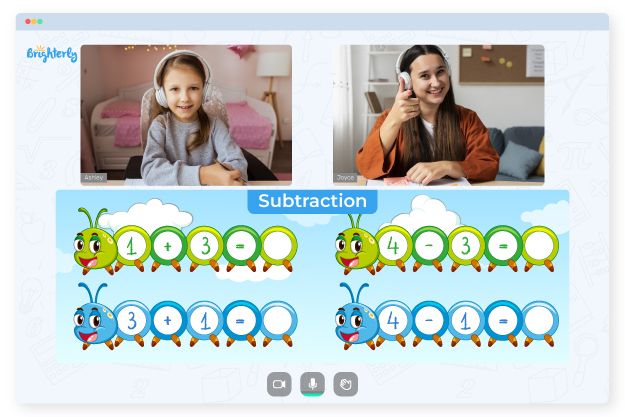Subtraction With Regrouping
Updated on January 13, 2024
Welcome to Brighterly, the go-to online resource for engaging and effective math education for children. In today’s article, we dive into the fascinating world of subtraction with regrouping. As a crucial skill in arithmetic, mastering subtraction with regrouping sets the stage for tackling more complex mathematical operations with confidence and accuracy.
At Brighterly, we understand that learning math can be a challenging endeavor, but we believe in making it fun, accessible, and rewarding for young minds. Through our creative and interactive approach, we aim to empower children to excel in mathematics while fostering a love for the subject. Our expertly crafted content ensures that children not only grasp the fundamental concepts but also enjoy the learning process.
What is Subtraction With Regrouping?
Subtraction with regrouping, also known as borrowing or renaming, is a method used to subtract numbers where the digits in the subtrahend (the number being subtracted) are greater than the corresponding digits in the minuend (the number from which subtraction is performed). When this occurs, regrouping is necessary to perform the subtraction accurately.
Subtraction With Regrouping Steps
The steps involved in subtraction with regrouping are straightforward and can be easily mastered with practice. Here’s a simplified breakdown:
- Start by aligning the minuend and subtrahend vertically, with corresponding digits in each column.
- Begin subtracting from the rightmost column (ones place) and proceed to the left.
- If the digit in the subtrahend is larger than the corresponding digit in the minuend, regroup by borrowing from the next higher place value column.
- Subtract the regrouped amount from the higher place value column and add it to the corresponding digit in the subtrahend column.
- Complete the subtraction by subtracting the regrouped amount from the digit in the minuend column.
- Repeat these steps for each subsequent column.
You can find the answers to the practice questions provided in this article, along with additional practice questions, in our comprehensive Subtraction With Regrouping Worksheets. Designed specifically to reinforce the concept of subtraction with regrouping, this worksheet offers a range of carefully crafted exercises to further enhance your child’s skills and confidence.
2-Digit Subtraction With Regrouping
When subtracting two-digit numbers with regrouping, the process is similar to the general steps mentioned earlier. Let’s consider an example: 54 – 27.
-
Align the numbers vertically:
54
27
- Subtract the ones place: 4 – 7. Since 4 is smaller than 7, we need to regroup.
- Borrow 1 ten from the tens place, making it 4 tens (40) instead of 5 tens.
- Add the borrowed ten (10) to the ones place, making it 14.
- Subtract 7 from 14: 14 – 7 = 7.
- Subtract 2 from 4 tens: 4 – 2 = 2.
- The final answer is 27.
3-Digit Subtraction With Regrouping
As the numbers become larger, the process remains the same but involves regrouping in multiple columns. Let’s consider the example: 437 – 259.
-
Align the numbers vertically:
437
259
- Subtract the ones place: 7 – 9. Regrouping is required.
- Borrow 1 ten from the tens place, making it 3 tens (30) instead of 4 tens.
- Add the borrowed ten (10) to the ones place, making it 17.
- Subtract 9 from 17: 17 – 9 = 8.
- Subtract 5 from 3 tens: 30 – 5 = 25.
- Subtract the hundreds: 4 – 2 = 2.
- The final answer is 178.
4-Digit Subtraction With Regrouping
Extending the concept to four-digit numbers follows the same pattern. Let’s take an example: 8,375 – 2,416.
-
Align the numbers vertically:
8,375
2,416
- Subtract the ones place: 5 – 6. Regrouping is necessary.
- Borrow 1 ten from the tens place, making it 6 tens (60) instead of 7 tens.
- Add the borrowed ten (10) to the ones place, making it 15.
- Subtract 6 from 15: 15 – 6 = 9.
- Subtract 1 from 7 tens: 70 – 10 = 60.
- Subtract the hundreds: 7 – 1 = 6.
- Subtract the thousands: 8 – 2 = 6.
- The final answer is 5,959.
Subtraction of Decimals With Regrouping
Subtraction with regrouping is not limited to whole numbers; it can also be applied to decimals. When subtracting decimals, it is essential to align the decimal points before proceeding with the regrouping process. The steps remain similar to those used for whole numbers, but attention must be paid to the correct placement of the decimal point in the final answer.
Examples on Subtraction With Regrouping
To further illustrate subtraction with regrouping, let’s explore a few additional examples:
-
86 – 37:
86
37
Regrouping is not necessary in this case. Subtracting the ones place, we get 6 – 7 = -1. Since we can’t have negative digits, we need to regroup from the tens place. Borrowing 1 ten from 8 tens, we make it 7 tens (70). Adding the borrowed ten to the ones place, we get 16 – 7 = 9. The final answer is 49.
-
523 – 288:
523
288
No regrouping is required. Subtracting the ones place, we get 3 – 8. We need to borrow 1 ten from the tens place, making it 12. Subtracting 8 from 12, we get 4. Subtracting the tens, we have 1 – 8. Borrowing 1 hundred from the hundreds place, we make it 4 hundreds (400). Subtracting 8 from 400, we get 392. The final answer is 235.
Practice Questions on Subtraction With Regrouping
To reinforce the understanding of subtraction with regrouping, here are some practice questions for you:
- 427 – 198
- 1,657 – 983
- 76.45 – 38.79
- 3,284 – 2,156
Try solving these exercises using the steps outlined earlier, and check your answers to gauge your progress.
Conclusion
In conclusion, subtraction with regrouping is a fundamental skill that plays a vital role in a child’s mathematical journey. With a solid understanding of the step-by-step procedures and ample practice, students can strengthen their ability to solve more complex subtraction problems with ease and accuracy.
At Brighterly, we are committed to providing the best resources and tools to support children in their mathematical growth. Our engaging and interactive approach to learning ensures that children not only grasp the concept of subtraction with regrouping but also develop a deep appreciation for the subject.
Frequently Asked Questions on Subtraction With Regrouping
Is subtraction with regrouping the same as borrowing?
Yes, subtraction with regrouping is often referred to as borrowing or renaming. It involves borrowing from a higher place value column to accurately perform the subtraction.
At what grade level do children learn subtraction with regrouping?
Subtraction with regrouping is typically introduced in the second or third grade when children have a solid understanding of basic subtraction. However, the exact timing may vary depending on the curriculum and the individual student’s progress.
How can I help my child practice subtraction with regrouping?
Providing your child with practice materials, such as worksheets or online interactive games, can be helpful. Additionally, engaging in hands-on activities, using manipulatives like base-ten blocks, can enhance understanding and make learning more enjoyable.
Are there any alternative methods to subtraction with regrouping?
While subtraction with regrouping is the most commonly taught method, alternative approaches such as the “number line method” or “counting up” can also be used. These alternative methods may be helpful for children who are still developing a solid grasp of regrouping.
How can I address common challenges or misconceptions related to subtraction with regrouping?
It’s important to provide ample practice opportunities and use visual representations to reinforce the concept. Encourage students to check their work by adding the difference to the subtrahend to ensure that the result matches the minuend.






